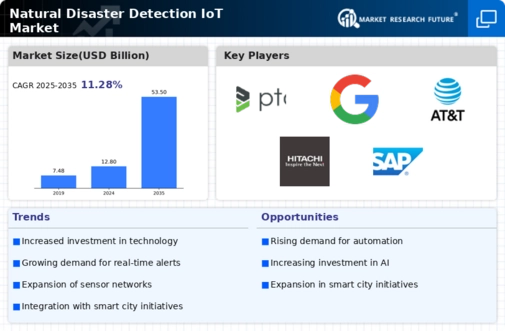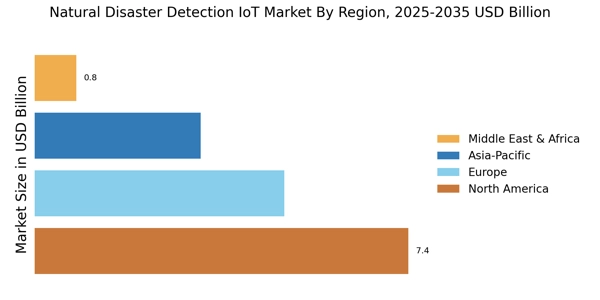Technological Advancements in IoT
Technological advancements in IoT are propelling the Natural Disaster Detection IoT Market forward. Innovations in sensor technology, data analytics, and connectivity are enabling more accurate and timely detection of natural disasters. For instance, the integration of real-time data processing allows for immediate alerts to be sent to emergency services and the public. The market is projected to grow as these technologies become more affordable and accessible. Furthermore, the proliferation of 5G networks enhances the capabilities of IoT devices, facilitating faster communication and data transfer. As a result, the Natural Disaster Detection IoT Market is poised for expansion, driven by the need for reliable and efficient disaster management solutions.
Government Initiatives and Funding
Government initiatives and funding play a crucial role in the growth of the Natural Disaster Detection IoT Market. Many governments are recognizing the importance of investing in disaster preparedness and response systems. This has led to the allocation of substantial budgets for the development and implementation of IoT-based detection systems. For example, various countries have launched programs aimed at enhancing their disaster resilience through technology. The financial support from public sectors not only accelerates the adoption of IoT solutions but also encourages private sector participation. As a result, the Natural Disaster Detection IoT Market is likely to benefit from increased investments and collaborative efforts between governments and technology providers.
Integration of Smart City Initiatives
The integration of smart city initiatives is significantly influencing the Natural Disaster Detection IoT Market. As urban areas expand, the need for efficient disaster management systems becomes more pressing. Smart city projects often incorporate IoT technologies to enhance infrastructure resilience and improve emergency response capabilities. This integration allows for the seamless collection and analysis of data from various sources, enabling quicker decision-making during disasters. The trend towards smart cities is likely to drive demand for advanced detection systems, as municipalities seek to protect their residents and assets. Consequently, the Natural Disaster Detection IoT Market is expected to grow in tandem with the development of smart urban environments.
Rising Frequency of Natural Disasters
The increasing frequency of natural disasters, such as hurricanes, floods, and wildfires, is a primary driver for the Natural Disaster Detection IoT Market. According to recent data, the number of natural disasters has escalated significantly over the past decade, leading to heightened awareness and demand for advanced detection systems. Governments and organizations are investing in IoT technologies to enhance their disaster response capabilities. This trend is expected to continue, as climate change contributes to more unpredictable weather patterns. Consequently, the Natural Disaster Detection IoT Market is likely to experience substantial growth as stakeholders seek to mitigate risks and protect communities from the devastating impacts of these events.
Growing Public Awareness and Preparedness
Growing public awareness regarding the risks associated with natural disasters is driving the Natural Disaster Detection IoT Market. As communities become more informed about the potential impacts of disasters, there is a rising demand for effective detection and warning systems. Educational campaigns and community engagement initiatives are fostering a culture of preparedness, prompting individuals and organizations to seek out IoT solutions. This trend is reflected in the increasing sales of IoT devices designed for disaster detection and monitoring. The Natural Disaster Detection IoT Market is expected to thrive as public interest in safety and preparedness continues to rise, leading to greater investment in innovative technologies.


















Leave a Comment